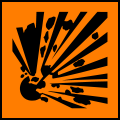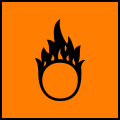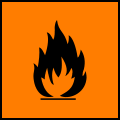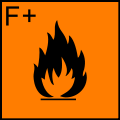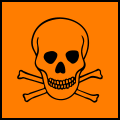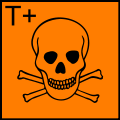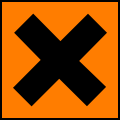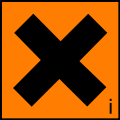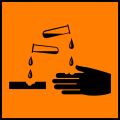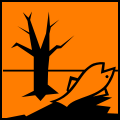To use all functions of this page, please activate cookies in your browser.
my.chemeurope.com
With an accout for my.chemeurope.com you can always see everything at a glance – and you can configure your own website and individual newsletter.
- My watch list
- My saved searches
- My saved topics
- My newsletter
Hazard symbol
Hazard symbols are easily recognizable symbols designed to warn about hazardous materials or locations. The use of hazard symbols is often regulated by law and directed by standards organizations. Hazard symbols may appear with different colors, backgrounds, borders and supplemental information in order to signify the type of hazard. Additional recommended knowledge
Common hazard symbols
Radioactive sign The international radiation symbol (also known as trefoil) first appeared in 1946, at the University of California, Berkeley Radiation Laboratory. At the time, it was rendered as magenta, and was set on a blue background.[2] It is drawn with a central circle of radius R, an internal radius of 1.5R and an external radius of 5R for the blades, which are separated from each other by 60°.[3]
 On February 15, 2007, the IAEA and the ISO announced this new ionizing radiation symbol to supplement the traditional trefoil symbol. The new symbol is aimed at alerting anyone, anywhere to the potential dangers of being close to a large source of ionizing radiation. [4]
Biohazard sign Developed by Dow Chemical company in the 1960s for their containment products.[5] According to Charles Dullin, an environmental-health engineer who contributed to its development:
DrawingAll parts of the Biohazard sign can be drawn with a compass and/or ruler. The basic outline of the symbol is a plain trefoil, which is three circles overlapping each other equally like in a triple venn diagram with the overlapping parts erased. The diameter of the overlapping part is equal to half the radius of the three circles. Then three inner circles are drawn in with 2/3 radius of the original circles so that it's little tangent to the outside three overlapping circles. A tiny circle in center has a diameter 1/2 of the radius of the three inner circle, and arcs are erased at 90°, 210°, 330°. The arcs of the inner circles and the tiny circle are connected by a line. Finally, the ring under is drawn from the distance to the perimeter of the equilateral triangle that forms between the centers of the three intersecting circles. An outer circle of the ring under is drawn and finally enclosed with the arcs from the center of the inner circles with a shorter radius from the inner circles.[7]
Toxic sign The skull and crossbones symbol, consisting of a human skull and two bones crossed together under the skull, is today generally used as a warning of danger, particularly in regard to poisonous substances. The symbol, or some variation thereof, was also featured on the Jolly Roger, the traditional flag of European and American pirates. It is also used by the Skull and Bones, a secret society at Yale University, and is part of the WHMIS home symbols placed on containers to confirm that the substance inside is dangerous in a way. In the USA, due to concerns that the skull and bones symbol's association with pirates encourages children to play with toxic materials, the Mr. Yuk symbol is also used to denote poison. Warning sign On warning signs, an exclamation mark is often used to draw attention to a warning of danger, hazards and the unexpected.
Chemical hazardA chemical hazard label is a pictogram applied to containers of dangerous chemical compounds to indicate the specific risk, and thus the required precautions. There are several systems of labels. The U.S.-based National Fire Protection Association (NFPA) has a standard NFPA 704 using a diamond with four colored sections each with a number indicating severity 0-4 (0 for no hazard, 4 indicates a severe hazard). The red section denotes flammability. The blue section denotes health risks. Yellow represents reactivity (tendency to explode). The white section denotes special hazard information. This label is used primarily in the USA. In Europe, another standard is used, as fixed in the ADR-Agreement. Vehicles carrying dangerous goods have to be fitted with orange signs, where the lower number identifies the substance, while the upper number is a key for the threat it may pose. European hazard symbolsThese hazard symbols for chemicals are defined in Annex II of Directive 67/548/EEC. A consolidated list with translations into other EU languages can be found in Directive 2001/59/EC (See the links section). The 'n' in Harmful (Xn) stands for the French word nocif and the Italian word nocivo (noxious). See also
References
|
|||||||||||||||||||||||||||||||||||||||||||||||||||||||||||
| This article is licensed under the GNU Free Documentation License. It uses material from the Wikipedia article "Hazard_symbol". A list of authors is available in Wikipedia. |







